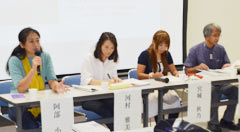Peace Studies Association of Okinawa demands that U.S. government regulate military aircraft noise

Researchers discussed the peace movement and education at the annual meeting of the Peace Studies Association of Okinawa at the University of the Ryukyus campus in Nishihara in the afternoon of October 20.
October 21, 2013 Ryukyu Shimpo
The Peace Studies Association of Okinawa held its annual meeting at the University of the Ryukyus in Nishihara on October 20. At the meeting, Takeshi Tokashiki, associate professor at the university explained that low-frequency sound generated by the MV-22 Osprey impacts upon human bodies. He said, “The problem is that the Japanese government let the U.S. military deploy the Osprey to Okinawa without testing the noise produced by the aircraft.” Tokashiki demanded that the governments regulate the noise pollution.
Masami Kawamura, director of the Citizen’s Network for Biodiversity in Okinawa, referred to dioxin and other harmful materials found inside barrels unearthed at a soccer ground on land in Okinawa City that had been returned by the U.S. military. She explained that the network examined the results of the examination that the central and city governments carried out, saying, “It is becoming clear that dioxin and other harmful materials inside the barrels have polluted the area.” She suggested that the central government should allow citizens to cross-check the results of surveys by public agencies.
Member of the Lepidopterological Society of Japan’s Nature Conservation Committee Akino Miyagi criticized the U.S. military for building helipads in Takae, Higashi Village. She said, “Everyone sees this as destruction of the natural environment.” Miyagi continued, “Politics make researchers hesitate about looking into the destruction of nature in the area. If more researchers focus on what is happening at Takae there will be more discoveries.”
The participants listened to reports from editors of local history books and testimonies from survivors of the Battle of Okinawa. They discussed how to convey people’s war experiences to future generations based on individual stories. A member of the Itoman Education Board, Yumiko Kashima, explained that the board has surveyed 37,000 survivors of the battle. She said, “We gathered facts little by little to find out what the battle was really like.”
Participants in the meeting actively exchanged opinions under the theme of peace movement and education.
(English translation by T&CT, Mark Ealey)
Previous Article:Construction of Naha Port international distribution center to begin in FY 2015
Next Article:Okinawa Soba Day
[Similar Articles]
- Dioxins detected in all analyses of barrels found in Okinawa City
- Levels of Agent Orange ingredients found in Okinawa City exceed Environmental Quality Standard
- Okinawa detects Agent Orange ingredients in barrels found on land returned by U.S. military
- Toxic dioxin found inside barrels unearthed at a soccer ground on land returned by the U.S. military in Okinawa City
- Ginowan citizens complain of 90-decibel national anthem broadcast from MCAS Futenma
 Webcam(Kokusai Street)
Webcam(Kokusai Street)


